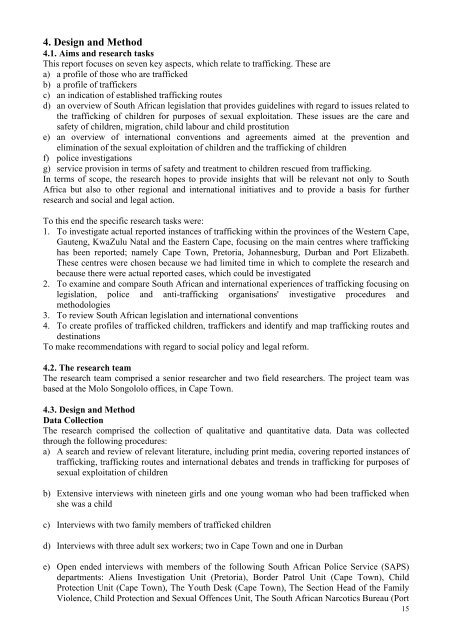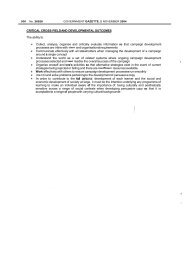The trafficking of children for purposes of sexual exploitation
The trafficking of children for purposes of sexual exploitation
The trafficking of children for purposes of sexual exploitation
Create successful ePaper yourself
Turn your PDF publications into a flip-book with our unique Google optimized e-Paper software.
4. Design and Method<br />
4.1. Aims and research tasks<br />
This report focuses on seven key aspects, which relate to <strong>trafficking</strong>. <strong>The</strong>se are<br />
a) a pr<strong>of</strong>ile <strong>of</strong> those who are trafficked<br />
b) a pr<strong>of</strong>ile <strong>of</strong> traffickers<br />
c) an indication <strong>of</strong> established <strong>trafficking</strong> routes<br />
d) an overview <strong>of</strong> South African legislation that provides guidelines with regard to issues related to<br />
the <strong>trafficking</strong> <strong>of</strong> <strong>children</strong> <strong>for</strong> <strong>purposes</strong> <strong>of</strong> <strong>sexual</strong> <strong>exploitation</strong>. <strong>The</strong>se issues are the care and<br />
safety <strong>of</strong> <strong>children</strong>, migration, child labour and child prostitution<br />
e) an overview <strong>of</strong> international conventions and agreements aimed at the prevention and<br />
elimination <strong>of</strong> the <strong>sexual</strong> <strong>exploitation</strong> <strong>of</strong> <strong>children</strong> and the <strong>trafficking</strong> <strong>of</strong> <strong>children</strong><br />
f) police investigations<br />
g) service provision in terms <strong>of</strong> safety and treatment to <strong>children</strong> rescued from <strong>trafficking</strong>.<br />
In terms <strong>of</strong> scope, the research hopes to provide insights that will be relevant not only to South<br />
Africa but also to other regional and international initiatives and to provide a basis <strong>for</strong> further<br />
research and social and legal action.<br />
To this end the specific research tasks were:<br />
1. To investigate actual reported instances <strong>of</strong> <strong>trafficking</strong> within the provinces <strong>of</strong> the Western Cape,<br />
Gauteng, KwaZulu Natal and the Eastern Cape, focusing on the main centres where <strong>trafficking</strong><br />
has been reported; namely Cape Town, Pretoria, Johannesburg, Durban and Port Elizabeth.<br />
<strong>The</strong>se centres were chosen because we had limited time in which to complete the research and<br />
because there were actual reported cases, which could be investigated<br />
2. To examine and compare South African and international experiences <strong>of</strong> <strong>trafficking</strong> focusing on<br />
legislation, police and anti-<strong>trafficking</strong> organisations' investigative procedures and<br />
methodologies<br />
3. To review South African legislation and international conventions<br />
4. To create pr<strong>of</strong>iles <strong>of</strong> trafficked <strong>children</strong>, traffickers and identify and map <strong>trafficking</strong> routes and<br />
destinations<br />
To make recommendations with regard to social policy and legal re<strong>for</strong>m.<br />
4.2. <strong>The</strong> research team<br />
<strong>The</strong> research team comprised a senior researcher and two field researchers. <strong>The</strong> project team was<br />
based at the Molo Songololo <strong>of</strong>fices, in Cape Town.<br />
4.3. Design and Method<br />
Data Collection<br />
<strong>The</strong> research comprised the collection <strong>of</strong> qualitative and quantitative data. Data was collected<br />
through the following procedures:<br />
a) A search and review <strong>of</strong> relevant literature, including print media, covering reported instances <strong>of</strong><br />
<strong>trafficking</strong>, <strong>trafficking</strong> routes and international debates and trends in <strong>trafficking</strong> <strong>for</strong> <strong>purposes</strong> <strong>of</strong><br />
<strong>sexual</strong> <strong>exploitation</strong> <strong>of</strong> <strong>children</strong><br />
b) Extensive interviews with nineteen girls and one young woman who had been trafficked when<br />
she was a child<br />
c) Interviews with two family members <strong>of</strong> trafficked <strong>children</strong><br />
d) Interviews with three adult sex workers; two in Cape Town and one in Durban<br />
e) Open ended interviews with members <strong>of</strong> the following South African Police Service (SAPS)<br />
departments: Aliens Investigation Unit (Pretoria), Border Patrol Unit (Cape Town), Child<br />
Protection Unit (Cape Town), <strong>The</strong> Youth Desk (Cape Town), <strong>The</strong> Section Head <strong>of</strong> the Family<br />
Violence, Child Protection and Sexual Offences Unit, <strong>The</strong> South African Narcotics Bureau (Port<br />
15
















